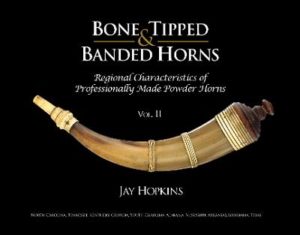Heating Cow Horn by The Horn Swogglers
August 31, 2010 by Bill Carter
Filed under Articles from the Archives
The article selected from the archives for this segment is from the February 2005 issue entitled “Heating Cow Horn” by the Horn Swogglers. I have no idea who the “Horn Swogglers” were, but they employed a rather humorous approach to the age old question concerning the heating of horn.
This article also ties in nicely with Willy Frankfort’s article on the “Horn Kiln” which will be in the September 2010 issue of The Horn Book.
-Bill Carter
Heating Cow Horn
By The Horn Swogglers
For those of you who have experienced the frustration of inaccurate information about how to work horn and thus have been horn-swoggled, this column will help ease your agitation and set the record straight. It’s written by the most knowledgeable, but not necessarily humble, horn workers in the world, and based on the most current information from NASA, spanning the entire galaxy. Here we will answer the perplexing questions that HCH members have about the horner’s craft. So, if you’ve ever been horn-swoggled, that is, bamboozled, befuddled, or bewildered, about working horn, send your inquiries to The Horn Book Editor, our very own Lee Larkin (known in some circles as “Lurkin” Larkin, for reasons we will not go into here), via email or snail-mail, and he will forward each and every one of them on to us. This prevents the U.S. Postal Service from having to create an entire new zip code for yours truly, the Horn Swogglers, and also gives Lee something to do.
Our first question, picked at random from the stack of mail we keep tripping over on the shop floor, has to do with “correctly heating horn.” The “burning” question is, “What is the correct way to heat horn?”
Now, this may seem a little round-about, so just bear with us here. Picture yourself in the “Horner’s Game Show,” trying to choose the door that is hiding the correct answer. How would you choose the right door? We asked that great horn-swoggler Jack Horner, sitting over in the corner of our shop, and he said, “You could try sniffing each door.” From our experience though, the human nose only tells the brain, “Something stinks – get out of here,” and then, after approximately 96 seconds, you can’t distinguish smells very well anymore. So, if you sniff too long at any one door, it will all start smelling the same real fast. On top of that, horn heated “wet or dry” has different odors, so smelling the doors is a very limited option. After further speculation and debate, we threw up our hands, and decided to just start at door number one – forget the grand prize.
Behind door number one we found Mr. Ronny Horner. He’s heard all about horning from his rendezvous buds who tell him that you just need to boil the horn in water to soften it. The reason Ronny is behind door number one is because it is attached to his dog house, which is his current postal address. Ronny tried boiling horn on the kitchen stove. He boiled and boiled and boiled his horn, and forgot that Mrs. Ronny Horner was bringing the “Power Through Prayer” ladies group over for ice cream. Too bad for Ronny! After all that, we’ve heard on good authority that Ronny’s horn was still not soft enough to be worked, and that Ronny’s olfactory senses are now gone. But he still has eyes and ears, so we’ll make this real plain for him: boiling horn in water was never, is never, and never will be, the correct way to heat horn hot enough to work it so that the horn retains its strength and looses its original memory. Well, maybe we should move on to door number two.
Behind door number two is Hairy Horner. Hairy’s name is an acronym of the technique he uses – hot air. Hairy knows that horn has to be heating greater than what Ronny could get with boiling water and has decided to pull out his old paint stripping hot air gun. Unfortunately, Hairy stripped so many houses in the neighborhood with his hot air gun that the fumes from the lead based paint seem to have already turned Hairy a little airy. Actually, the gun gets the horn hot enough, but because of the air flow, it dries and dehydrates the horn too quickly, and the horn scorches and melts rather that becoming plastic. Notice also that Hairy’s door is connected to his garage which is connected to the kitchen. Hairy thinks that Mrs. Hairy Horner won’t mind the smell in the garage. It just goes to show how much affect lead oxide has on the brain, has on the brain. We should continue our search and look behind door number three.
“Holy Cow!” Mic Horner’s shop or “lab” looks like something from “Nightmare Before Christmas.” You might think because of his name that Mic is descended from ancient Celtic horners, but you would be mistaken. Mic’s name actually comes from his heat source – the “Mic”rowave oven. Notice also that door number three is actually the kitchen door. Mic hasn’t learned a thing from the sad experiences of Ronny or Hairy. Or, to quote a great American hero, ‘Stupid is as stupid does.” Mic’s horn is frizzled beyond use. Frizzled is his middle name and frazzled are his nerves. Putting horn into a microwave is like putting your finger in a hot light socket. Mic even tried the defrost and popcorn settings, but to no avail. Poor Mic will be heating his TV dinners on the steam vent near the city rescue mission this winter and his wife will be filing for P.F.A. All you aspiring horners should take note, and “fear and shudder.”
And, finally, we come to door number four (bet you thought there were only three doors in this horner’s game). Well, behind door number four, we find Hap Horner. Hap’s name is no mistake. He’s a happy horner. It just so happens that Hap heard about the HCH and hastily joined before he haplessly made all of the above horrible errors. Hap’s door actually leads to a real shop that is not attached in any way to his house. To use dry heat, Hap has set up a grill outside of his shop where he can heat his horn over a fire. Otherwise, he uses an electric hot plate in his shop. He also has an oven in his shop to bake horn. For wet heat, Hap has an old pot or turkey fryer full of lard. Hap still has most of his brain and olfactory functions. Not only that, but, you guessed it, Hap is still happily married. The grill, oven and fryer are not the baubles of a divorce settlement, but were consented to by Mrs. Hap Horner, so they could live in health, harmony, and happiness. Pretty smart, huh?
Whether by the grill, which takes a practiced eye, or by the oven, which takes a 300 degree setting, or by the fryer, at no more that 320 degrees of wet heating, the goal is to make a piece of horn plastic so that when it cools it will not loose its strength, but will loose the memory of its old shape and permanently retain the memory of the new shape. The only time a horn should be boiled is when the bone core is separated from the horn after the horn is removed from the cow (we strongly recommend doing this 1.) after the cow is dead, and 2.) outside!). And, so, a deep, dark mystery of the horn trade is answered by the indubitable Horn Swogglers. To quote another great American, “Shazam!” ᾨ





Bill,
The Horn Swogglers was inspired and written by Roland. Lee typed it up from his hand written notes. He also did a version of the same article for Muzzle Loader or Muzzle Blast some years ago. Some keep asking him to do more but he has yet to give in and do the followups.
Pam
My problem is scorching a white, scrimshaw quality horn while using the oven at 300 degrees to heat treat. As soon as the temp is right, the horn is removed and reshaped. But the edges are scorched.
What can I do to prevent this from happening?
Kenneth
Hello,
Thanks for the article on horn heating, I only have one question, what it the heating time-frame for each application?
Thank You,
Rick
Many thanks for the article on heating horn. I have an 18th century lantern that originally had horn panes. The lantern is cylindrical, and so the 4 panes are also sections of a cylinder. Is the 300 degree temperature correct for delaminating the horn, and again, for how long?
Again, thanks,
George